The WaterSense Current Fall 2013
Issue XXVIII, Fall 2013
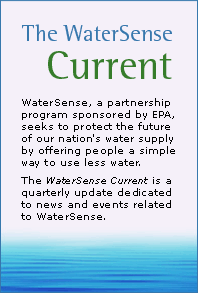 |
In This Issue: |
2013 WaterSense Awards Showcase Sustained Partner Support
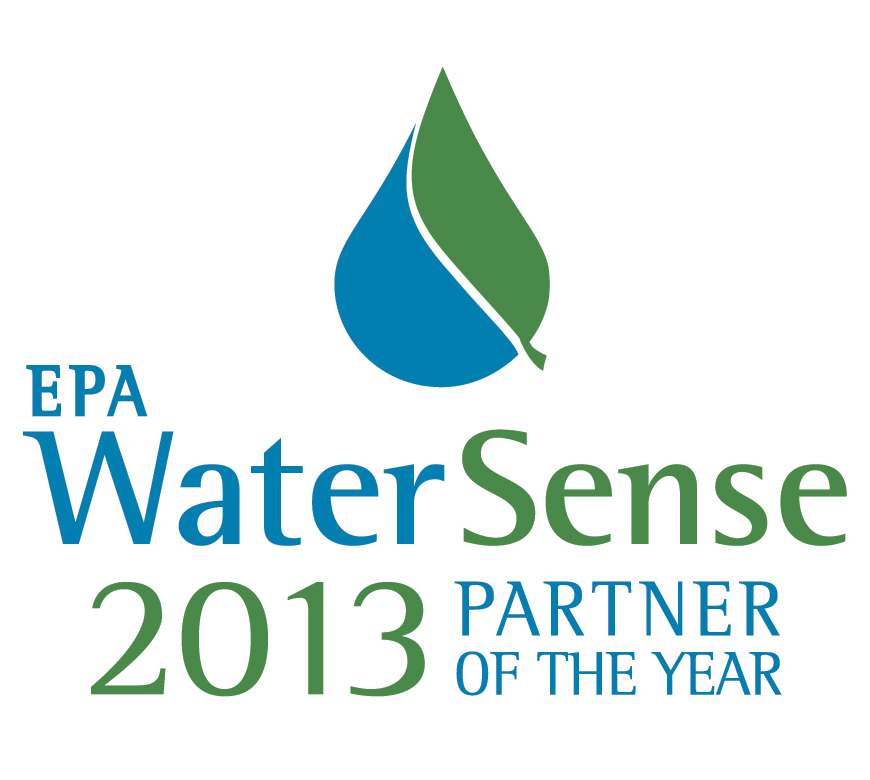
WaterSense 2013 Excellence
Award Winners
- Excellence in Promoting WaterSense Labeled Products: City of Boulder (Colorado) Public Works/Utilities
- Excellence in Strategic Collaboration: Colorado Springs (Colorado) Utilities
- Excellence in Education and Outreach: Public Service Commission of Wisconsin; Town of Sharon (Massachusetts)
- Excellence in Promotion: Sonoma-Marin (California) Saving Water Partnership
- Excellence in Construction of Affordable WaterSense Labeled New Homes: Habitat for Humanity of Metro Denver (Colorado)
It takes more than just a label to save 487 billion gallons of water and $8.9 billion in water and energy bills—WaterSense partners really drive the savings. In early October, the U.S. Environmental Protection Agency (EPA) announced its 2013 WaterSense Partners of the Year, including honoring two partners that have provided consistent support over the past several years with its first-ever Sustained Excellence Awards.
To qualify for a Sustained Excellence Award, a partner must have won three WaterSense Partner of the Year awards in the past five years and must have applied for an award in each of the past five years. Two partners achieved this distinction in 2013: Kohler Co. and Lowe's Companies, Inc.
As a three-time WaterSense Manufacturer Partner of the Year and two-time WaterSense Excellence Award winner, Kohler's sustained water efficiency efforts have evolved into a one-stop-shop website, SaveWaterAmerica.com, which features WaterSense labeled products, consumer tips to save water, and a calculator to estimate the savings achieved by Kohler's labeled products.
Lowe's Companies, Inc., a three-time WaterSense Retailer Partner of the Year and 2011 Excellence Award winner, nearly doubled the number of WaterSense labeled showerhead models available in its stores in 2012 and increased its total online inventory of all labeled models. The company also developed a smartphone application so employees can quickly find WaterSense labeled product rebates for shoppers and provided bilingual product information on its website.
EPA additionally recognized seven WaterSense Partners of the Year for their efforts to drive innovation in manufacturing, educate consumers, and transform the market for water efficiency in 2012:
- The Athens-Clarke County (Georgia) Public Utilities Department received the 2013 WaterSense Promotional Partner of the Year award for piloting a commercial water conservation program to educate restaurant owners and managers on the high-performing, water-saving benefits of installing WaterSense labeled products.
- Delta Faucet Company was named a 2013 WaterSense Manufacturer Partner of the Year in the large manufacturer category for conducting a coast-to-coast effort during Fix a Leak Week 2012 to nip drips nationwide by collaborating with several WaterSense utility partners in 10 different cities, resulting in more than 7 million gallons in estimated annual water savings.
- In the small manufacturer category, Niagara Conservation Corp. was also honored with a 2013 WaterSense Manufacturer Partner of the Year award for ensuring 96 percent of its core product line of toilets, showerheads, and lavatory faucet accessories were WaterSense labeled in 2012—a nearly 10 percent increase compared to 2011.
- The Home Depot was named the 2013 WaterSense Retailer Partner of the Year for the second consecutive year for collaborating with manufacturers and local utilities to establish WaterSense labeled product rebates that helped customers benefit from more than $33 million in product markdowns.
- Earning its third consecutive WaterSense Builder Partner of Year award, KB Home continued to break new ground in 2012 with the construction of its first Washington, D.C., area net-zero energy use home that earned the WaterSense label for its water-efficient features inside and out.
- The Irrigation Association (IA) took home the coveted 2013 WaterSense Professional Certifying Organization Partner of Year, the award category's inaugural winner. Worthy of the bragging rights, four out of six of the IA's certification programs are WaterSense labeled, and many of its certified professionals have become irrigation partners.
- John Taylor, president of Taylor Irrigation Service, Inc., in Houston, Texas, was named the 2013 WaterSense Irrigation Partner of the Year for overhauling his company's business model in 2012 to focus on water-smart landscaping, efficient irrigation practices, and WaterSense labeled irrigation controllers.
The honors don't end there! Learn more about this year’s six Excellence Award winners and more details about the water efficiency efforts driven by the 2013 WaterSense Sustained Excellence and Partners of the Year award winners.
"Shower Better" to Celebrate Energy Awareness Month
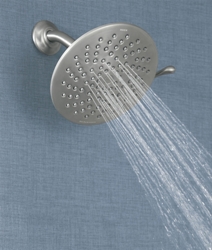
October is Energy Awareness Month, the perfect time to save energy, water, and money by using WaterSense labeled products. For example, it takes energy to pump, heat, treat, and deliver water to your showerhead, but using a WaterSense labeled model saves both drops and watts by using less hot water to deliver a satisfying shower. What's more, WaterSense labeled showerheads have been independently certified to meet EPA’s criteria for water efficiency, force, and spray coverage, so you can be confident you're showering better.
Showering is one of the leading ways we use water in the home, accounting for nearly 17 percent of all U.S. residential indoor water use, or about 30 gallons per household per day. That's about 1.2 trillion gallons of water every year nationwide!
From your morning routine to your post-gym rinse, using a WaterSense labeled showerhead is one of the simplest ways to save water, energy, and money without sacrificing the level of coverage you've come to expect. By replacing a showerhead with a WaterSense labeled model, the average family can save more than 2,900 gallons of water each year—equivalent to the amount it takes to wash more than 70 loads of laundry.
You can also spend your shower relaxing rather than worrying about utility bills. A WaterSense labeled showerhead can save the amount of electricity it takes to power the average family's home for 13 days and reduce their annual water and energy costs by more than $70.
You might be able to save even more on a WaterSense labeled showerhead this October and year-round if your local utility offers a rebate. Browse our WaterSense Rebate Finder to learn more. And for those parents looking to curb their kids' shower duration, or teachers interested in educating students about the water-energy nexus, check out WaterSense's new kids' learning resource (2 pg, 545K, About PDF) to help them make the drops-to-watts connection.
Something’s Cooking Up New Savings in Commercial Kitchen
 Your favorite restaurant may soon be adding water savings to the menu. Pre-rinse spray valves, which remove excess food waste from dishes prior to dishwashing, can now earn the WaterSense label. These valves can account for one-third of the water used in a typical commercial kitchen. A restaurant that replaces just one pre-rinse spray valve with a WaterSense labeled model could recoup its investment in as little as four to eight months and save more than $115 per year on water and energy costs.
Your favorite restaurant may soon be adding water savings to the menu. Pre-rinse spray valves, which remove excess food waste from dishes prior to dishwashing, can now earn the WaterSense label. These valves can account for one-third of the water used in a typical commercial kitchen. A restaurant that replaces just one pre-rinse spray valve with a WaterSense labeled model could recoup its investment in as little as four to eight months and save more than $115 per year on water and energy costs.
WaterSense labeled pre-rinse spray valves use no more than 1.28 gallons per minute—20 percent less water than the federal standard. Like all WaterSense labeled products, these valves must be independently certified to save water and perform well. To ensure that these fixtures will meet the demands of high-volume kitchens while using less water, EPA also includes spray force performance criteria and a requirement for life cycle testing for the products to earn the WaterSense label.
The release of the final WaterSense Specification for Commercial Pre-Rinse Spray Valves marks the program's first label for commercial kitchen products. WaterSense worked with a variety of stakeholders, including ENERGY STAR® and the American Society of Mechanical Engineers (ASME)/Canadian Standards Association (CSA), to evaluate pre-rinse spray valve performance and develop a meaningful test protocol. The ASME/CSA project team was open to the public and comprised a wide variety of stakeholders, including manufacturers, utilities, testing laboratories, representatives from ASTM International, and other water efficiency experts.
With the release of this final specification, food service managers and equipment purchasers can look for the WaterSense label on pre-rinse spray valves before the end of the year. If every U.S. commercial food service establishment installed and used a WaterSense labeled pre-rinse spray valve, we could save more than 10 billion gallons of water and more than $225 million in water and energy costs annually across the country.
Installing WaterSense labeled pre-rinse spray valves isn't the only way to save. Learn more about what WaterSense is doing to help restaurants, hotels, schools, and cafeterias save water, energy, and money.
UT Austin Achieves Back-to-School Water Savings

Educational facilities such as schools, universities, museums, and libraries account for approximately 6 percent of U.S. commercial and institutional facilities' total water use, with 45 percent of water consumption taking place in restrooms. By working to save and reuse water, staff at the University of Texas at Austin's (UT Austin's) 400-acre campus reduced the university's water use by more than 33 percent, saving $7.5 million in water and energy bills along the way.
UT Austin serves approximately 51,000 students and 24,000 faculty and staff in nearly 20 million square feet of space. Although the university continues to expand its campus, UT Austin's comprehensive water conservation program has resulted in declining water use over the years. In the early 1980s, UT Austin's facilities were using 1 billion gallons of potable water per year. As of 2010, UT Austin had reduced this water use to 668 million gallons, which was achieved despite a 70 percent increase in overall building square footage. Much of this reduction is attributed to the use of onsite alternative water sources. Once the largest water-using entity in Austin, Texas, the university's effort to recover and reuse water has saved it 1.6 billion gallons of water over the past two decades.
UT Austin had previously used single-pass cooling water—sent down the drain at a rate of 1 gallon per minute (gpm) 24 hours per day, 365 days per year—to cool drinking fountains and laboratory equipment. Recognizing this opportunity for water recovery, UT Austin installed a network of underground PVC pipes to pre-treat and send this water to the campus' cooling tower for reuse.
In addition, all campus buildings constructed in the past six years have been equipped with rainwater harvesting systems with as much as 5,000 gallons worth of tank storage. Depending upon the amount of rainfall, UT Austin recovers 40 to 50 million gallons of water annually through this system and reuses it for lawn irrigation.
Read the full case study about UT Austin's efforts. To learn more about how other types of commercial and institutional facilities are reducing their water use, see WaterSense at Work's case studies collection.
Fill and Revitalize Urban Cores With Water Savings
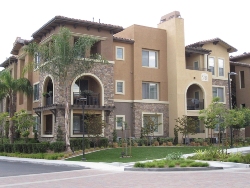
EPA Region 6 Hosts Builders Symposium
EPA Region 6 is partnering with the Texas A&M AgriLife Research and Extension Center-Dallas and other organizations to host the Dallas-Fort Worth Builders Symposium. It has been postponed from the original date of October 16, 2013 and will be rescheduled to a new date in early 2014. This free symposium, to take place at the Texas A&M AgriLife Research and Extension Center in Dallas, Texas, will discuss how such programs as the WaterSense New Homes program are helping build water-efficient homes nationwide. Learn more![]() about the symposium and updated registration information as it becomes available.
about the symposium and updated registration information as it becomes available.
As the housing market continues to rebound, many communities are looking to capitalize on this momentum by using smart growth principles that capitalize on revitalizing long-abandoned downtowns with urban infill projects. In addition to offering new economic opportunities for communities, developers can also break new ground in the green building industry by including water-efficient WaterSense labeled apartments or condos (1 pg, 127K, About PDF) in their portfolios. These multi-family homes are independently certified to use less water in both the units and common areas, so residents can breathe new life into their downtown areas while saving water for future generations.
Designed to save water inside and out, these apartments and condos feature WaterSense labeled toilets, showerheads, and bathroom sink faucets, as well as efficient hot water delivery systems, water-smart landscapes, and the ability for each unit to monitor its water use. Not only do units' hot water delivery systems save water, they save energy and the time it takes hot water to travel to the faucet or shower—meaning you won't be late for your bus or light-rail train waiting for warm water to reach the tap or tub.
WaterSense labeled multi-family units can save as much as 50,000 gallons of water per year—equivalent to the amount of water needed to wash 2,000 loads of laundry! In addition, each unit's efficient features can save as much as $600 in water and energy bills each year. These savings reduce your "blue" footprint and translate to more money left over for a night on the town.
If WaterSense labeled apartments and condos aren't yet available near your community, you can still follow a few simple steps to reduce water use:
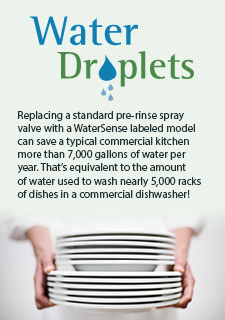
- Nip those drips: The average household's leaks can account for more than 10,000 gallons of water wasted every year, or the amount of water needed to wash 270 loads of laundry! Report dripping faucets, running toilets, or leaky showerheads to your landlord or building manager. Visit our Fix a Leak Week page to learn more.
- Load up on savings: When using a dishwasher, make sure it's fully loaded before starting a cycle. The same applies to laundry—wash only full loads of clothes and linens, or use the appropriate water level and load size selection on the washing machine.
- Turn off the tap: Don't let the water run while shaving or brushing teeth. While you're at it, keep a pitcher of drinking water in the refrigerator instead of letting the faucet run until the water is cool.
- Be clean and green: Showers use less water than baths, as long as you keep an eye on how long you've been lathering up. Want to shower even better? Switch to a WaterSense labeled showerhead and save water and energy while you shower with power.
- Take the pledge: Join thousands of Americans in pledging to reduce your water use
 . Then, follow WaterSense on Facebook
. Then, follow WaterSense on Facebook and Twitter
and Twitter and help spread the word yourself. Every pledge counts!
and help spread the word yourself. Every pledge counts!
For more information about WaterSense labeled apartments and condos, visit the WaterSense page on buying new homes. Visit the WaterSense page on saving water for more water-smart ways to do more with less.




